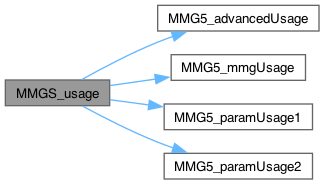 |
Mmg
Simplicial remeshers (mesh adaptation, isovalue discretization, lagrangian movement)
|
 |
Mmg
Simplicial remeshers (mesh adaptation, isovalue discretization, lagrangian movement)
|
Tools functions for the mmgs library. More...
#include "libmmgs.h"#include "libmmgs_private.h"#include "inlined_functions_private.h"#include "mmgsexterns_private.h"#include "mmgexterns_private.h"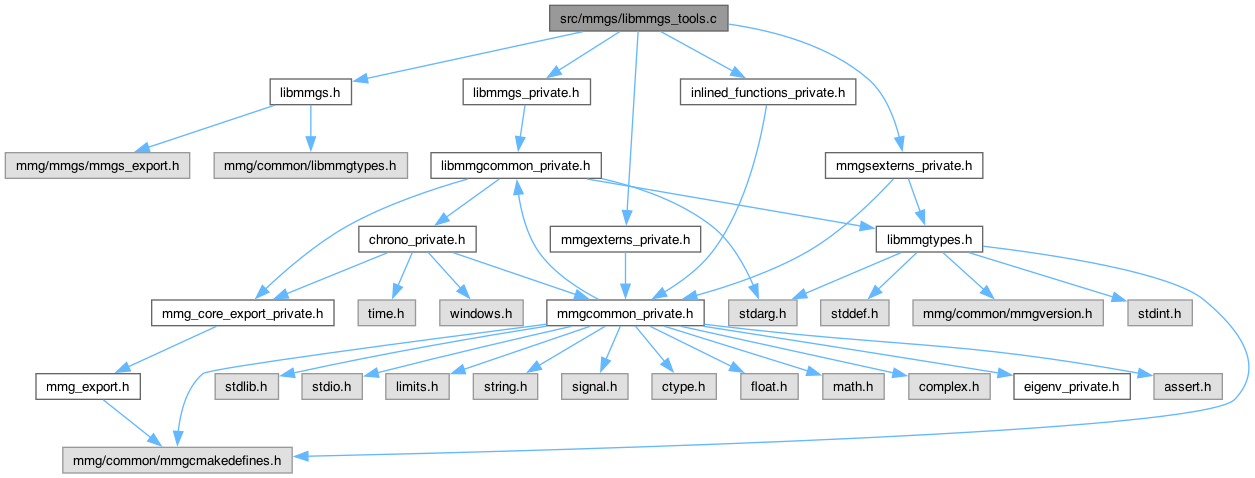
Go to the source code of this file.
Functions | |
| void | MMGS_setfunc (MMG5_pMesh mesh, MMG5_pSol met) |
| Set function pointers for caltet, lenedg, defsiz and gradsiz. | |
| int | MMGS_usage (char *prog) |
| Print help for mmgs options. | |
| int | MMGS_defaultValues (MMG5_pMesh mesh) |
| Print the default parameter values. | |
| int | MMGS_parsar (int argc, char *argv[], MMG5_pMesh mesh, MMG5_pSol met, MMG5_pSol sol) |
| Store command line arguments. | |
| int | MMGS_freeLocalPar (MMG5_pMesh mesh) |
| int | MMGS_stockOptions (MMG5_pMesh mesh, MMG5_Info *info) |
| Store the info structure in the mesh structure. | |
| void | MMGS_destockOptions (MMG5_pMesh mesh, MMG5_Info *info) |
| Recover the info structure stored in the mesh structure. | |
| int | MMGS_Get_numberOfNonBdyEdges (MMG5_pMesh mesh, MMG5_int *nb_edges) |
| Get the number of non-boundary edges. | |
| int | MMGS_Get_nonBdyEdge (MMG5_pMesh mesh, MMG5_int *e0, MMG5_int *e1, MMG5_int *ref, MMG5_int idx) |
| Get vertices and reference of a non-boundary edge. | |
| int | MMGS_Get_adjaTri (MMG5_pMesh mesh, MMG5_int kel, MMG5_int listri[3]) |
| Return adjacent triangles of a triangle. | |
| int | MMGS_Get_adjaVerticesFast (MMG5_pMesh mesh, MMG5_int ip, MMG5_int start, MMG5_int lispoi[MMGS_LMAX]) |
| Find adjacent vertices of a triangle. | |
| static int | MMGS_solTruncatureForOptim (MMG5_pMesh mesh, MMG5_pSol met, int ani) |
| int | MMGS_doSol_iso (MMG5_pMesh mesh, MMG5_pSol met) |
| static int | MMGS_unitTensor_3D (MMG5_pMesh mesh, MMG5_int k, int i, MMG5_pPoint p1, double *m) |
| static int | MMGS_surfopenballRotation (MMG5_pMesh mesh, MMG5_pPoint p0, MMG5_int k, int i, int ilist, double r[3][3], double *lispoi, double n[3]) |
| static int | MMGS_unitTensor_2D (MMG5_pMesh mesh, MMG5_int k, int i, MMG5_pPoint p1, double *m, double isqhmax) |
| int | MMGS_doSol_ani (MMG5_pMesh mesh, MMG5_pSol met) |
| int | MMGS_Set_constantSize (MMG5_pMesh mesh, MMG5_pSol met) |
| Compute a constant size map. | |
| int | MMGS_Compute_eigenv (double m[6], double lambda[3], double vp[3][3]) |
| Compute the real eigenvalues and eigenvectors of a symmetric matrix. | |
| void | MMGS_Free_solutions (MMG5_pMesh mesh, MMG5_pSol sol) |
| Free a solution. | |
| int | MMGS_Clean_isoSurf (MMG5_pMesh mesh) |
| Clean data (triangles and edges) linked to isosurface. | |
Tools functions for the mmgs library.
Definition in file libmmgs_tools.c.
| int MMGS_Clean_isoSurf | ( | MMG5_pMesh | mesh | ) |
Clean data (triangles and edges) linked to isosurface.
| mesh | pointer to mesh structure |
SUBROUTINE MMGS_CLEAN_ISOSURF(mesh,retval)
MMG5_DATA_PTR_T, INTENT(IN) :: mesh
INTEGER, INTENT(OUT) :: retval
END SUBROUTINE
Definition at line 1640 of file libmmgs_tools.c.


| int MMGS_Compute_eigenv | ( | double | m[6], |
| double | lambda[3], | ||
| double | vp[3][3] | ||
| ) |
Compute the real eigenvalues and eigenvectors of a symmetric matrix.
| m | upper part of a symmetric matrix diagonalizable in |R |
| lambda | array of eigenvalues |
| vp | array of eigenvectors |
Compute the real eigenvalues and eigenvectors of a symmetric matrix m whose upper part is provided (m11, m12, m13, m22, m23, m33 in this order).
lambda[0] is the eigenvalue associated to the eigenvector ( v[0][0], v[0,1], v[0,2] ) in C and to the eigenvector v(1,:) in fortran
lambda[1] is the eigenvalue associated to the eigenvector ( v[1][0], v[1,1], v[1,2] ) in C and to the eigenvector v(2,:) in fortran
lambda[2] is the eigenvalue associated to the eigenvector ( v[2][0], v[2,1], v[2,2] ) in C and to the eigenvector v(3,:) in fortran
SUBROUTINE MMGS_COMPUTE_EIGENV(m,lambda,vp,retval)
REAL(KIND=8), INTENT(IN) :: m(*)
REAL(KIND=8), INTENT(OUT) :: lambda(*),vp(*)
INTEGER, INTENT(OUT) :: retval
END SUBROUTINE
Definition at line 1607 of file libmmgs_tools.c.


| int MMGS_defaultValues | ( | MMG5_pMesh | mesh | ) |
Print the default parameter values.
| mesh | pointer to the mesh structure. |
SUBROUTINE MMGS_DEFAULTVALUES(mesh,retval)
MMG5_DATA_PTR_T, INTENT(INOUT) :: mesh
INTEGER, INTENT(OUT) :: retval
END SUBROUTINE
Definition at line 111 of file libmmgs_tools.c.


| void MMGS_destockOptions | ( | MMG5_pMesh | mesh, |
| MMG5_Info * | info | ||
| ) |
Recover the info structure stored in the mesh structure.
| mesh | pointer to the mesh structure. |
| info | pointer to the info structure. |
SUBROUTINE MMGS_DESTOCKOPTIONS(mesh,info)
MMG5_DATA_PTR_T, INTENT(INOUT) :: mesh,info
END SUBROUTINE
Definition at line 565 of file libmmgs_tools.c.

| int MMGS_doSol_ani | ( | MMG5_pMesh | mesh, |
| MMG5_pSol | met | ||
| ) |
| mesh | pointer to the mesh |
| met | pointer to the metric |
Compute the unit metric tensor at mesh vertices (from edges passing through the vertices).
Increment base marker to detect points already processed
Step 1: treat non-manifold points: travel triangle edges and add edge contribution to extremities (we have to do that because ball of non-manifold points can't be computed)
Corner point (no normal at vertex): if the corner defines an angle we can compute the 3D unit tensor (non singular), in the other cases (corner along a flat surface, for example because it is at the intersection of 3 specific edges or because it is provided by the user) we will project the edges onto the tangent plane and compute the 2D unit tensor (as for required and regular points)
Required point (no normal at vertex): projection of edges onto the tangent plane and computation of the 2D unit tensor
Ridge point (2 normals): normally we can compute the 3D unit tensor. If the angle is too flat, the computation fails and we try to compute the 2D unit tensor on the tangent plane of the point.
Regular or reference point: projection of edges onto the tangent plane and computation of the 2D unit metric tensor
Step 3: check computed metric
Step 4: computation of hmin/hmax (if needed) and metric truncature
Definition at line 1334 of file libmmgs_tools.c.


| int MMGS_doSol_iso | ( | MMG5_pMesh | mesh, |
| MMG5_pSol | met | ||
| ) |
| mesh | pointer to the mesh |
| met | pointer to the metric |
Compute isotropic size map according to the mean of the length of the edges passing through a point.
Definition at line 859 of file libmmgs_tools.c.


| void MMGS_Free_solutions | ( | MMG5_pMesh | mesh, |
| MMG5_pSol | sol | ||
| ) |
Free a solution.
| mesh | pointer to the mesh structure |
| sol | pointer to the solution structure |
SUBROUTINE MMGS_FREE_SOLUTIONS(mesh,sol)
MMG5_DATA_PTR_T, INTENT(INOUT) :: mesh,sol
END SUBROUTINE
Definition at line 1613 of file libmmgs_tools.c.

| int MMGS_freeLocalPar | ( | MMG5_pMesh | mesh | ) |
Definition at line 544 of file libmmgs_tools.c.
| int MMGS_Get_adjaTri | ( | MMG5_pMesh | mesh, |
| MMG5_int | kel, | ||
| MMG5_int | listri[3] | ||
| ) |
Return adjacent triangles of a triangle.
| mesh | pointer to the mesh structure. |
| kel | triangle index. |
| listri | pointer to the array of indices of the three adjacent triangles of triangle kel (the index is 0 if there is no adjacent triangle). |
Find the indices of the 3 adjacent elements of triangle kel. \(v_i = 0\) if the \(i^{th}\) face has no adjacent element (so we are on a boundary face).
SUBROUTINE MMGS_GET_ADJATRI(mesh,kel,listri,retval)
MMG5_DATA_PTR_T, INTENT(INOUT) :: mesh
INTEGER(MMG5F_INT), INTENT(IN) :: kel
INTEGER(MMG5F_INT), DIMENSION(3), INTENT(OUT) :: listri
INTEGER, INTENT(OUT) :: retval
END SUBROUTINE
Definition at line 709 of file libmmgs_tools.c.


| int MMGS_Get_adjaVerticesFast | ( | MMG5_pMesh | mesh, |
| MMG5_int | ip, | ||
| MMG5_int | start, | ||
| MMG5_int | lispoi[MMGS_LMAX] | ||
| ) |
Find adjacent vertices of a triangle.
| mesh | pointer to the mesh structure. |
| ip | vertex index. |
| start | index of a triangle holding ip. |
| lispoi | pointer to an array of size MMGS_LMAX that will contain the indices of adjacent vertices to the vertex ip. |
Find the indices of the adjacent vertices of the vertex ip of the triangle start.
SUBROUTINE MMGS_GET_ADJAVERTICESFAST(mesh,ip,start,lispoi,retval)
MMG5_DATA_PTR_T, INTENT(INOUT) :: mesh
INTEGER(MMG5F_INT), INTENT(IN) :: ip,start
INTEGER(MMG5F_INT), DIMENSION(MMGS_LMAX), INTENT(OUT) :: lispoi
INTEGER(MMG5F_INT), INTENT(OUT) :: retval
END SUBROUTINE
Definition at line 723 of file libmmgs_tools.c.

| int MMGS_Get_nonBdyEdge | ( | MMG5_pMesh | mesh, |
| MMG5_int * | e0, | ||
| MMG5_int * | e1, | ||
| MMG5_int * | ref, | ||
| MMG5_int | idx | ||
| ) |
Get vertices and reference of a non-boundary edge.
| mesh | pointer to the mesh structure. |
| e0 | pointer to the first extremity of the edge (a vertex number). |
| e1 | pointer to the second extremity of the edge (a vertex number). |
| ref | pointer to the edge reference. |
| idx | index of the non boundary edge to get (between 1 and the number of edges) |
This function returns the vertices e0, e1 and reference ref of the non boundary edge idx. An edge is boundary if it is located at the interface of 2 domains with different references, if it belongs to one triangle only or if it is a singular edge (ridge or required).
SUBROUTINE MMGS_GET_NONBDYEDGE(mesh,e0,e1,ref,idx,retval)
MMG5_DATA_PTR_T,INTENT(INOUT) :: mesh
INTEGER(MMG5F_INT), INTENT(OUT):: e0,e1
INTEGER(MMG5F_INT) :: ref
INTEGER(MMG5F_INT), INTENT(IN) :: idx
INTEGER, INTENT(OUT) :: retval
END SUBROUTINE
Definition at line 667 of file libmmgs_tools.c.


| int MMGS_Get_numberOfNonBdyEdges | ( | MMG5_pMesh | mesh, |
| MMG5_int * | nb_edges | ||
| ) |
Get the number of non-boundary edges.
| mesh | pointer to the mesh structure. |
| the | number of edges pointer to the number of non boundary edges. |
Get the number of non-boundary edges (for DG methods for example). An edge is boundary if it is located at the interface of 2 domains with different references, if it belongs to one triangle only or if it is a singular edge (ridge or required). Append these edges to the list of edges.
SUBROUTINE MMGS_GET_NUMBEROFNONBDYEDGES(mesh,nb_edges,retval)
MMG5_DATA_PTR_T,INTENT(INOUT) :: mesh
INTEGER(MMG5F_INT), INTENT(OUT):: nb_edges
INTEGER, INTENT(OUT) :: retval
END SUBROUTINE
Definition at line 571 of file libmmgs_tools.c.


| int MMGS_parsar | ( | int | argc, |
| char * | argv[], | ||
| MMG5_pMesh | mesh, | ||
| MMG5_pSol | met, | ||
| MMG5_pSol | sol | ||
| ) |
Store command line arguments.
| argc | number of command line arguments. |
| argv | command line arguments. |
| mesh | pointer to the mesh structure. |
| met | pointer to the sol structure. |
| sol | pointer to a level-set or displacement |
Definition at line 126 of file libmmgs_tools.c.


| int MMGS_Set_constantSize | ( | MMG5_pMesh | mesh, |
| MMG5_pSol | met | ||
| ) |
Compute a constant size map.
| mesh | pointer to the mesh structure |
| met | pointer to the sol structure |
This function computes a constant size map according to mesh->info.hsiz, mesh->info.hmin and mesh->info.hmax. It updates these 3 values if they are not compatible.
SUBROUTINE MMGS_SET_CONSTANTSIZE(mesh,met,retval)
MMG5_DATA_PTR_T, INTENT(INOUT) :: mesh,met
INTEGER, INTENT(OUT) :: retval
END SUBROUTINE
Definition at line 1579 of file libmmgs_tools.c.

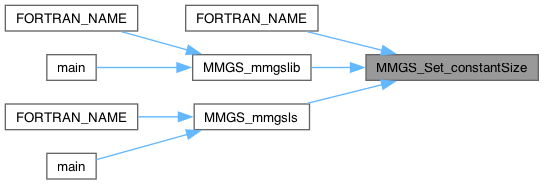
| void MMGS_setfunc | ( | MMG5_pMesh | mesh, |
| MMG5_pSol | met | ||
| ) |
Set function pointers for caltet, lenedg, defsiz and gradsiz.
To associate function pointers without calling MMGS_mmgslib
| mesh | pointer to the mesh structure (unused). |
| met | pointer to the sol structure (unused). |
SUBROUTINE MMGS_SETFUNC(mesh,met)
MMG5_DATA_PTR_T, INTENT(INOUT) :: mesh,met
END SUBROUTINE
Definition at line 43 of file libmmgs_tools.c.
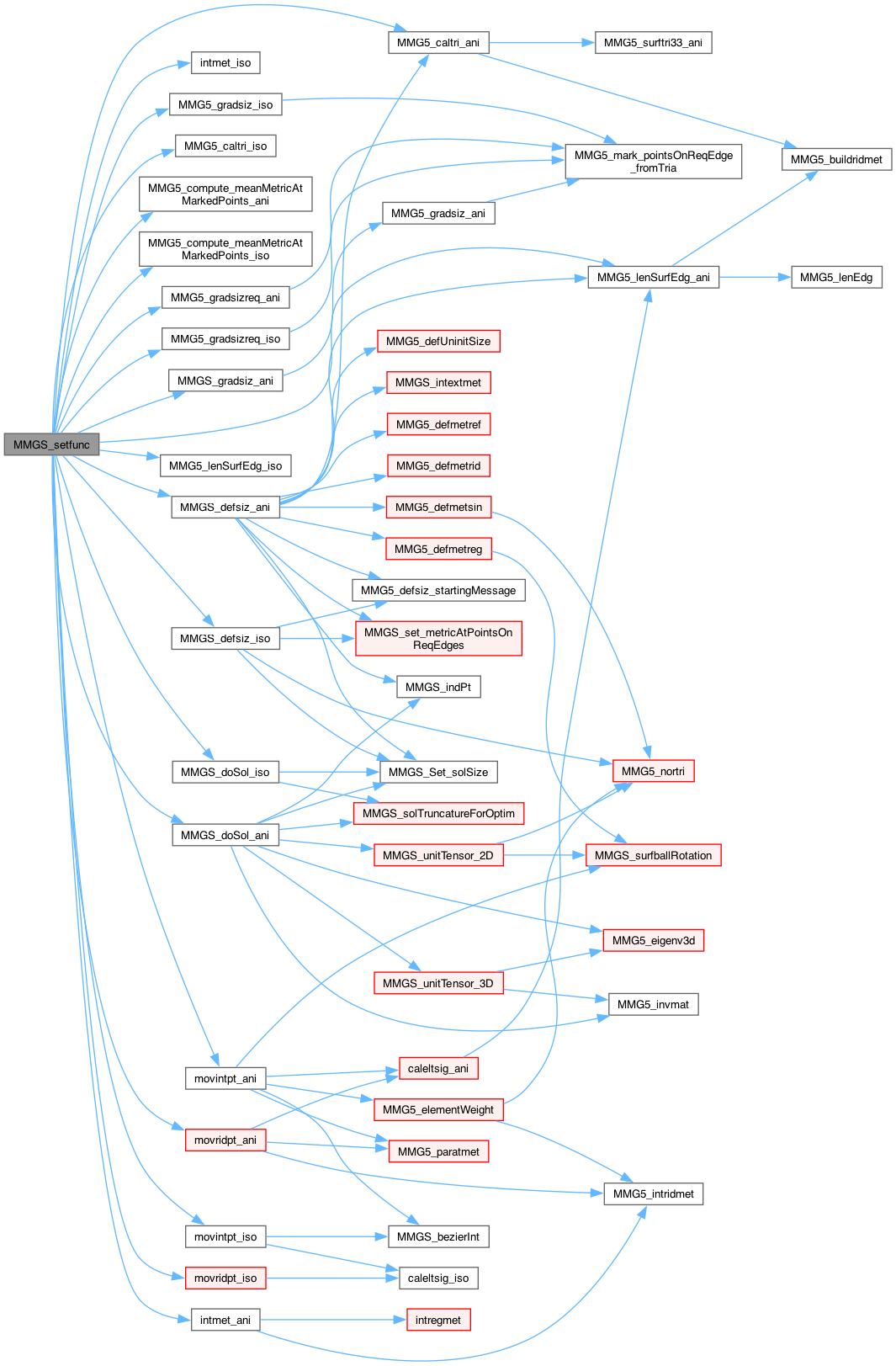
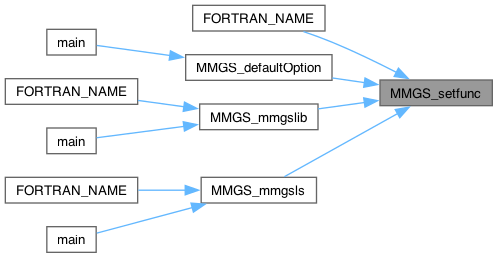
|
inlinestatic |
| mesh | pointer to the mesh structure. |
| met | pointer to the solution structure. |
| ani | 1 for aniso metric, 0 for iso one |
Truncate the metric computed by the DoSol function by hmax and hmin values (if setted by the user). Set hmin and hmax if they are not setted.
Definition at line 810 of file libmmgs_tools.c.


| int MMGS_stockOptions | ( | MMG5_pMesh | mesh, |
| MMG5_Info * | info | ||
| ) |
Store the info structure in the mesh structure.
| mesh | pointer to the mesh structure. |
| info | pointer to the info structure. |
SUBROUTINE MMGS_STOCKOPTIONS(mesh,info,retval)
MMG5_DATA_PTR_T, INTENT(INOUT) :: mesh,info
INTEGER, INTENT(OUT) :: retval
END SUBROUTINE
Definition at line 552 of file libmmgs_tools.c.


|
inlinestatic |
| mesh | pointer to the mesh structure. |
| p0 | starting point |
| k | index of starting element |
| i | local index of p0 in k |
| ilist | computed number of tria in the ball of p0 |
| r | rotation that send the normal at p0 onto the z vector |
| lipoint | rotated ball of point p0 |
| n | normal at point p0 |
Compute the rotation matrix that sends the tangent plane at p0 onto z=0 and apply this rotation to the opened ball of p0.
Definition at line 1050 of file libmmgs_tools.c.


|
inlinestatic |
| mesh | pointer to the mesh |
| k | index of starting triangle |
| i | local index of point p1 in k |
| p1 | point on which we want to compute the 3D unit tensor |
| m | pointer to store computed metric |
| isqhmax | squared inverse of MMG5_HMAXCOE |
Compute the 2D unit tensor at point p1, the vertex number i of tetra k : edges of the ball of point are projected onto the tangent plane.
Step 1: compute ball of point
Step 2: Store or compute the suitable normal depending on the type of point we are processing.
Step 3: Rotation of the ball of p0 so lispoi will contain all the points of the ball of p0, rotated so that t_{p_0}S = [z = 0]
Step 4: computation of unit tensor
Definition at line 1148 of file libmmgs_tools.c.


|
inlinestatic |
| mesh | pointer to the mesh |
| k | index of starting triangle |
| i | local index of point p1 in k |
| p1 | point on which we want to compute the 3D unit tensor |
| m | pointer to store computed metric |
Compute the 3D unit tensor at point p1, the vertex number i of tetra k.
Step 1: compute ball of point
Step 2: compute unit tensor
Definition at line 939 of file libmmgs_tools.c.


| int MMGS_usage | ( | char * | prog | ) |
Print help for mmgs options.
| prog | pointer to the program name. |
SUBROUTINE MMGS_USAGE(prog,strlen0,retval)
CHARACTER(LEN=*), INTENT(IN) :: prog
INTEGER, INTENT(IN) :: strlen0
INTEGER, INTENT(OUT) :: retval
END SUBROUTINE
Definition at line 83 of file libmmgs_tools.c.
